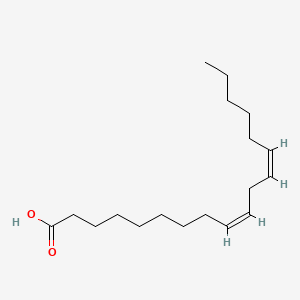Linoleic acid
Linoleic acid is a lipid of Fatty Acyls (FA) class. Linoleic acid is associated with abnormalities such as Diabetes Mellitus, Non-Insulin-Dependent, Metabolic syndrome, Obesity, Chronic Obstructive Airway Disease and Pneumonia. The involved functions are known as Insulin Resistance, Inflammation, Synthesis, Pathological accumulation of air in tissues and cytokine biosynthesis. The associated genes with Linoleic acid are TNF gene, CCL2 gene and TLR4 gene. The related lipids are palmitoleic acid, nervonic acid and Sphingolipids.
Cross Reference
Introduction
To understand associated biological information of Linoleic acid, we collected biological information of abnormalities, associated pathways, cellular/molecular locations, biological functions, related genes/proteins, lipids and common seen animal/experimental models with organized paragraphs from literatures.
What diseases are associated with Linoleic acid?
Linoleic acid is suspected in Obesity, Diabetes Mellitus, Non-Insulin-Dependent, Metabolic syndrome, Chronic Obstructive Airway Disease, Pneumonia and other diseases in descending order of the highest number of associated sentences.
Related references are mostly published in these journals:
| Disease | Cross reference | Weighted score | Related literature |
|---|
Possible diseases from mapped MeSH terms on references
We collected disease MeSH terms mapped to the references associated with Linoleic acid
PubChem Associated disorders and diseases
What pathways are associated with Linoleic acid
There are no associated biomedical information in the current reference collection.
PubChem Biomolecular Interactions and Pathways
Link to PubChem Biomolecular Interactions and PathwaysWhat cellular locations are associated with Linoleic acid?
There are no associated biomedical information in the current reference collection.
What functions are associated with Linoleic acid?
Related references are published most in these journals:
| Function | Cross reference | Weighted score | Related literatures |
|---|
What lipids are associated with Linoleic acid?
Related references are published most in these journals:
| Lipid concept | Cross reference | Weighted score | Related literatures |
|---|
What genes are associated with Linoleic acid?
Related references are published most in these journals:
| Gene | Cross reference | Weighted score | Related literatures |
|---|
What common seen animal models are associated with Linoleic acid?
There are no associated biomedical information in the current reference collection.
NCBI Entrez Crosslinks
All references with Linoleic acid
Download all related citations| Authors | Title | Published | Journal | PubMed Link |
|---|---|---|---|---|
| Ma C et al. | NAFLD causes selective CD4(+) T lymphocyte loss and promotes hepatocarcinogenesis. | 2016 | Nature | pmid:26934227 |
| Padayachee T et al. | The Detection of Metabolite-Mediated Gene Module Co-Expression Using Multivariate Linear Models. | 2016 | PLoS ONE | pmid:26918614 |
| Hellström F et al. | Association between plasma concentrations of linoleic acid-derived oxylipins and the perceived pain scores in an exploratory study in women with chronic neck pain. | 2016 | BMC Musculoskelet Disord | pmid:26916287 |
| Rashed MM et al. | Effect of ultrasonic treatment on total phenolic extraction from Lavandula pubescens and its application in palm olein oil industry. | 2016 | Ultrason Sonochem | pmid:26584982 |
| Troche JR et al. | Alcohol Consumption-Related Metabolites in Relation to Colorectal Cancer and Adenoma: Two Case-Control Studies Using Serum Biomarkers. | 2016 | PLoS ONE | pmid:26967509 |
| Takabe W et al. | Esterification of 24S-OHC induces formation of atypical lipid droplet-like structures, leading to neuronal cell death. | 2016 | J. Lipid Res. | pmid:27647838 |
| Zhang YH et al. | The Use of Gene Ontology Term and KEGG Pathway Enrichment for Analysis of Drug Half-Life. | 2016 | PLoS ONE | pmid:27780226 |
| Rodrigues HG et al. | Oral Administration of Linoleic Acid Induces New Vessel Formation and Improves Skin Wound Healing in Diabetic Rats. | 2016 | PLoS ONE | pmid:27764229 |
| Kojima K et al. | A simple method for isolation and construction of markerless cyanobacterial mutants defective in acyl-acyl carrier protein synthetase. | 2016 | Appl. Microbiol. Biotechnol. | pmid:27704180 |
| Tel-Çayan G et al. | A new fatty acid ester from an edible mushroom Rhizopogon luteolus. | 2016 | Nat. Prod. Res. | pmid:26987031 |
